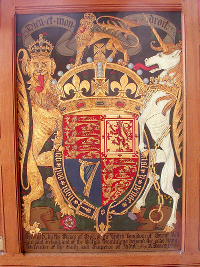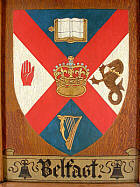Resources - The Herald Painter
In this section we will be illustrating the individual styles of different heraldic artists, primarily in the process of emblazoning arms for the preparation of Letters Patent. It will also demonstrate the different artistic interpretations that can be derived from similar heraldic blazons - a major factor that distinguishes heraldic art.
Featured Artist: A. Scott Carter, R.C.A.
 Our featured artist is considered Canada's earliest artist to devote his work largely to heraldry, both in painted and architectural form. The present display concentrates on his work in the former field. The examples have been selected from those on the south wall of the Great Hall of Hart House at the University of Toronto. These depict the shields of arms of a number of Canadian, British and Commonwealth universities in existence at the time of the First World War (those on the north wall show the arms of the universities of allied countries). It will be noticed that many of the shields are showing their age and clearly require repair and restoration. This is currently under way and it is to the conservator, Roumen Kirinkov, that we owe the photographs displayed in this feature.
Our featured artist is considered Canada's earliest artist to devote his work largely to heraldry, both in painted and architectural form. The present display concentrates on his work in the former field. The examples have been selected from those on the south wall of the Great Hall of Hart House at the University of Toronto. These depict the shields of arms of a number of Canadian, British and Commonwealth universities in existence at the time of the First World War (those on the north wall show the arms of the universities of allied countries). It will be noticed that many of the shields are showing their age and clearly require repair and restoration. This is currently under way and it is to the conservator, Roumen Kirinkov, that we owe the photographs displayed in this feature.
August 18, 2004
By R.G.M. Macpherson
Originally published in Heraldry in Canada, September, 1990
Alexander Scott Carter, one of Canada's pre-eminent heraldic artists, was born at Harrow, Middlesex, England in 1881. He studied art before graduating as an architect from the Polytechnic in London and practised in that field before coming to Toronto in 1912.
He became a member of the Royal Architectural Institute of Canada and specialized in architectural decoration and heraldic ornament. It is largely for his work in the art of heraldry that Scott Carter was acclaimed throughout Canada, the United States and England, as one of the outstanding artists of his time. In fact, it can be argued that few, if any, to this day, have ever captured that true spirit of heraldic art in the same manner and degree of excellence that he achieved.
I first met Mr. Carter in 1946 while still at school in Toronto and he was most kind and gracious to a self-taught artist who admired his work enormously. He was a very distinguished man with a small white moustache, very properly attired in English tweeds and with the unmistakable air of a scholar.
My study of his work began by my paying frequent visits to the Great Hall of Hart House to make countless sketches of his lions. And what magnificent lions they are! No one, in my opinion, seemed to accomplish with such amazing success that abstraction of the essential quality of a lion which was so typical of Scott Carter's style. If you have an opportunity to visit Hart House and examine the arms of the universities of the world, you cannot fail to be impressed by the lion on the shields of Lyons and Liege. Here is portrayed no sleepy or spiritless lion but rather a thin, hungry animal with long pointed claws and ferocity depicted on his countenance. A lion that expresses eagerness, fierceness, vigour and calculated, with mediaeval artistic skill, to strike awe into the heart of the spectator.
One other example of Scott Carter's lions may be found on the stone carvings on the Soldier's Tower beside Hart House, University of Toronto. There is a superb rendition of the Arms of England with beautifully proportioned lions, full of power and spirit. On the south wall there is another example of a single lion rampant which is really quite outstanding, While on the subject of Hart House, attention should be drawn to Mr. Carter's beautiful heraldic may in the Common Room. For splendid colour and magnificent design, there is nothing quite like it anywhere.
At Simcoe Hall, just across the campus, there is a very attractive carving in full colour of the Arms of John Graves Simcoe, which is certainly worth a visit. Trinity College contains numerous illustrations of Scott Carter's artistry and possibly my favourite is a large mural of the Royal Arms above the gallery in the dining hall.
Another magnificent mural executed by Mr. Carter was found in the main entrance foyer of the old Imperial Bank building at the south-east corner of King and Bay in Toronto. The mural included a large representation of the Royal Arms in the centre, surrounded by an ornate floral border which displayed the arms of the provinces. Alas, the building was demolished about 25 years ago and apparently the mural could not be saved.
Among Scott Carter's many heraldic works, special mention should be made of the Book of Remembrance which records the names of employees of the Bank of Nova Scotia who gave their lives in two world wars. This book may be seen at the bank's main office, King and Bay Streets in Toronto.
In addition, the following examples are worth recording:
- War Memorials at Upper Canada College and the head Office of Eaton's of Canada;
- Heraldic carvings, beautifully designed and executed, on the Queen Elizabeth Highway bridge at St. Catharines, Ontario;
- The Arms of Canada carved on the Bank of Canada building, Toronto, and on the Sunnybrook Hospital entrance gate;
- The reredos of St. Thomas's Church, Toronto, as well as the ceiling of its Lady Chapel;
- An armorial seal for the Toronto-Dominion Bank, which contains a classic example of a lion passant guardant;
- A seal for the Bank of Nova Scotia;
- A design of Arms for the Board of Education of Toronto and the Municipality of Metropolitan Toronto;
- Numerous heraldic bookplates including those for Sir Joseph Flavelle, Vincent Massey and Hamnet A. Dixon, which are typical of his style.
Scott Carter was elected A.R.C.A. in 1922 and R.C.A. in 1927. He died in 1968.
Note:  indicates the arms having been restored to date on this project.
indicates the arms having been restored to date on this project.
For an account of the restoration project at Hart House, click www.harthouse.utoronto.ca.
Hart House Heraldic Restoration needs Your Support
The Great Hall at Hart House, University of Toronto, houses one of the most important and distinguished armorial displays in Canada. The south wall of the Hall features the arms of the 51 degree-granting universities of the British Empire as of 1919, and the north wall the arms of 74 universities from countries allied with Canada during WWI. The artistic mastery of the legendary Alexander Scott Carter, the shields are lavishly gessoed, painted and gilded on oak panels. After more than 80 years, the shields are in need of expert restoration if they are to be preserved for future generations. An investment of $120,000 needs to be made to protect this national treasure. To date $56,000 has been donated to the project and work is underway on the south wall. To complete this important project, Hart House needs the support of those who value the artistry and the history embodied in this truly exceptional armorial display. To support the project, call Hart House Advancement at 416-946-0465, or log on to www.harthouse.utoronto.ca.










